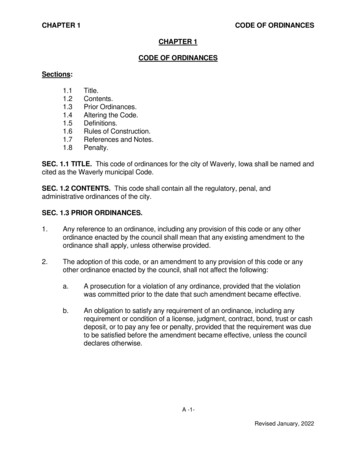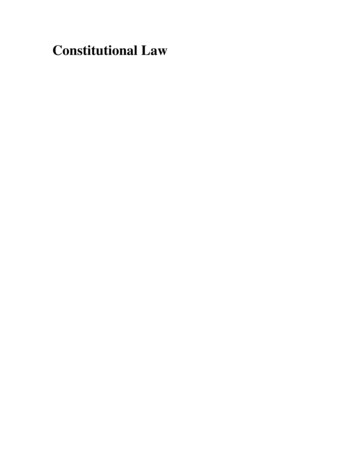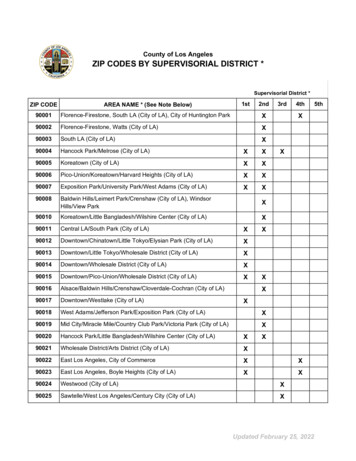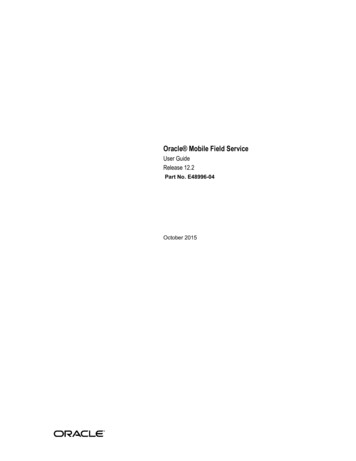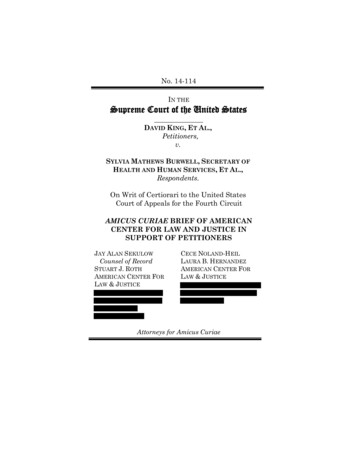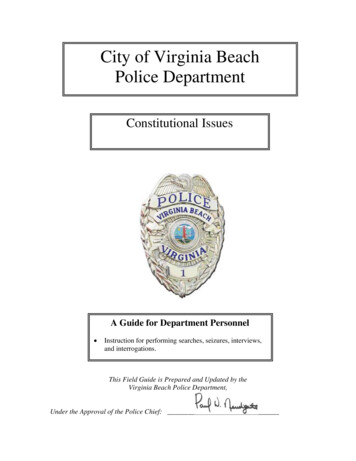
Transcription
City of Virginia BeachPolice DepartmentConstitutional IssuesA Guide for Department Personnel Instruction for performing searches, seizures, interviews,and interrogations.This Field Guide is Prepared and Updated by theVirginia Beach Police Department,Under the Approval of the Police Chief:
Page 2 of 103Constitutional Issues Field GuideTABLE OF CONTENTSPurpose . 4Policy . 4Introduction . 4Seizure vs. Non-Seizure of Persons . 5Investigative Stops and Arrests . 8Reasonable Suspicion & Probable Cause. 15Profiling . 23“Non-Searches”:.25Consent .26Plain View.29Sensory Perception.30Enhancement Tools .31Abandoned Property .33Open Fields & Woods . 344th Amendment Waivers. 36Searches of Persons:. 37Frisks . 37Plain Feel .39Probable Cause & Exigent Circumstances .39Search Incident to Arrest. 40Strip Searches & Body Cavity Searches . 41Vehicle Stops and Searches .43Checkpoints. 43Pretextual Stops . 44Consent . 45Frisks . 46Search Incident to Arrest. 47Carroll Doctrine. 47Containers . 49Inventory Searches . 49Community Caretaker Doctrine . 50Tracking Devices .50Forced Entry into Private Premises . 51Exigent Circumstances .52Hot Pursuit . 53Original: 01-15-2010 Effective: 01-12-2022 Amends: 11-04-2021
Constitutional Issues Field GuidePage 3 of 103Crime Scenes .55Community Caretaker Doctrine . 55Search Warrants . 58“Good Faith” . 67Use of Force .70Interview & Interrogation .76Miranda Warnings .77Custody . 77Waivers . 81Exceptions . 82Juveniles . 87Mentally Ill. 88Right to Silence . 89Right to Counsel . 90Non-Testimonial Identification Procedures . 95Glossary .102Original: 01-15-2010 Effective: 01-12-2022 Amends: 11-04-2021
Page 4 of 103Constitutional Issues Field GuidePurposeTo establish a training manual for understanding constitutional issues of search and seizure andinterview and interrogation.PolicyMembers of the Virginia Beach Police Department will scrupulously honor the United StatesConstitution, the Constitution of Virginia, and all statutory law and case law that govern this agency.INTRODUCTIONMost of this field guide deals with interpretation of the Fourth Amendment to the United StatesConstitution – the law of “Search and Seizure”. Consequently, it should begin with definitions of thosetwo terms, as used in Fourth Amendment constitutional law.[Note: Some cited cases in this field guide are from courts that have no jurisdiction over the courts inVirginia. These case opinions should be viewed as persuasive but not controlling.]What is a “Search”?A search occurs whenever there is a governmental intrusion upon a reasonable expectation of privacy.If an officer walks by a car that is in a public place and looks into the car through the window, he hasnot conducted a search; a person cannot reasonably expect privacy in what he exposes to public view.On the other hand, if an officer opens the trunk of a car and merely looks into the trunk, a search hasoccurred because the officer intruded into a zone where privacy can reasonably be expected. The factthat the officer did not touch or move any item in the trunk is irrelevant. Once the officer has intrudedupon a reasonable expectation of privacy, he has conducted a search. Unless a valid consent has beenobtained, a search must be justified either by a search warrant or some recognized exception to thesearch warrant requirement.What is a “Seizure”?A seizure of property occurs when an officer interferes meaningfully or significantly with anotherperson’s possessory interest in property. Requiring that someone hand over a weapon during a briefdetention is not a seizure because the “interference” with a “possessory interest” is not significant.Taking that same weapon (non-consensually) to the police department for “safekeeping” or forprocessing is a seizure.A seizure of a person occurs when an officer says or does things that would cause a reasonable personto feel that he is not free to leave or otherwise to decline participation. So if a uniformed officerapproaches someone on a sidewalk and says “Hold up there I need to talk to you”, a reasonableperson would feel he was being required to stop. Assuming he does stop (submits), as instructed, aseizure has occurred. In other words, a person is seized when, by means of physical force or a show ofauthority and a subsequent submission to that show of authority, freedom of movement is restrained.“Unreasonableness” and its ConsequencesThe Fourth Amendment prohibits “unreasonable” searches and seizures. To be reasonable, searches andOriginal: 01-15-2010 Effective: 01-12-2022 Amends: 11-04-2021
Constitutional Issues Field GuidePage 5 of 103seizures must be justified by facts and/or circumstances suggesting the need for them – probable cause,for example. Without such justification, searches and seizures are unreasonable and thereforeunconstitutional. Any evidence that is the direct product of a violation of someone’s constitutionalrights is inadmissible in a criminal prosecution of the person whose rights were violated. An officerwho intentionally violates someone’s constitutional rights is guilty of a federal felony. 18 U.S.C. §§ 241and 242 Civil lawsuits against police for alleged constitutional rights violations are commonplaceacross the United States. 42 U.S.C. § 1983This field guide contains hundreds of examples of what courts find to be reasonable, and unreasonable,searches and seizures. In other portions of this field guide are discussions of the law of interview andinterrogation – the Miranda Rule and interpretations of the Fifth and Sixth Amendments. The fieldguide begins with the law of officer-citizen contacts, seizures and non-seizures of persons.SEIZURE VS. NON-SEIZURE OF PERSONSThe Fourth Amendment to the United States Constitution requires that all searches and seizures,including seizures of persons, be reasonable. Determining the reasonableness of a seizure involvesbalancing the individual’s right to be free and left alone by police with the occasional need of lawenforcement to interfere with privacy and freedom in order to investigate crime and enforce laws. Thefollowing is an examination of the legal concepts involved in officer-citizen contacts, including seizuresof persons.For purposes of federal constitutional law, officer-citizen contacts fall into one of three legalcategories (See also McGee v. Commonwealth, 25 Va. App. 193):1. Voluntary Contact2. Investigative Detention (“Terry Stop”)3. ArrestInvestigative detentions and arrests are “seizures;” voluntary contacts are not. Black’s Law Dictionarydefines, in part, an arrest as “the stopping, seizing, or apprehending a person by lawful authority; the actof laying hands upon a person for the purpose of taking the body into custody of the law.” Courts mayuse different words to describe these transactions but, ultimately, there are only three categories.Officers are required to control a contact so that it does not escalate into an intrusion (seizure) forwhich the officer may not have legal justification. Before it can be determined what legal justification,if any, is required for the contact, it is necessary to determine what type of contact is taking place. Inorder to do that, one must know the characteristics of each type of contact.The Voluntary ContactWhere there is no “seizure” within the meaning of the Fourth Amendment, there is no FourthAmendment requirement of “reasonable” factual justification for the contact. In a voluntary contact,police need not have or prove reasonable suspicion or probable cause.While a “free to leave” inquiry is often determinative, it is not the sole test for whether an officercitizen contact is a seizure. There are circumstances in which someone is not necessarily free to leave,but the contact still may be voluntary in the legal sense.Original: 01-15-2010 Effective: 01-12-2022 Amends: 11-04-2021
Constitutional Issues Field GuidePage 6 of 103For example: Suppose in an attempted armed robbery of a convenience store clerk, the clerk andgunman scuffle. The perpetrator fires but only wounds himself. He flees but police find his blood andobtain his physical description. Thirty minutes later, police learn that a person has arrived at a nearbyhospital with a gunshot wound; he matches the description of the robbery suspect. Police go to thehospital and obtain permission from the emergency room doctor to speak with the suspect while he isawaiting treatment in an examination room. The doctor tells police that the subject has not receivedany medication and that his wound is superficial. There ensues the following conversation with thesuspect:Officer: “Good afternoon. I’m Officer John Smith with the City Police Department. How are youfeeling?”Suspect: “O.K. A few stitches and I’ll be as good as new.”Officer: “Great. Sir, may I have your permission to talk with you a moment? Would you allow meto do that?”Suspect: “Sure. No problem. What’s up?”In this scenario, the suspect arguably was not free to leave in that he was waiting in a hospital toreceive treatment for his injury. Still, it appears he was free to decline the contact with the officer.Nothing in the officer’s communication indicated otherwise. He asked the suspect to participate in thetransaction; there were no words of command, demand, requirement, or instruction. Though thesuspect may not have been “free to leave,” circumstances indicated he was “free to decline.”Therefore, the contact is not a seizure. The “free to decline” test has been applied by the United StatesSupreme Court in several cases, including United States v. Drayton, 122 S. Ct. 2105 (2002), Floridav. Bostick, 111 S. Ct. 2382 (1991), and I.N.S. v. Delgado, 104 S. Ct. 1758 (1984).More frequently, however, the “free to leave” test will be sufficient to govern the categorization of thecontact. Example: An officer observes a young man walking in an area where a number of burglarieshave occurred recently. With no other specific information in mind, the officer approaches the citizenand says, “Excuse me sir, may I speak with you for a moment?” The man stops and says, “Yeah, whatis it?” The officer identifies himself and asks if he could see some identification, which the managreeably produces. The officer reviews the identification, returns it to the man, and asks a fewquestions, and the two part ways. Because the officer said and did nothing that would cause areasonable person to feel restrained or otherwise required to participate in the contact, this contact isentirely voluntary in the legal sense. See Richmond v. Commonwealth, 22 Va. App. 257 (1996) andCommonwealth v. Morton, 00 Vap UNP 0497002 (2000).The United States Supreme Court has held that, if all a police officer does is approach a subject,identify himself as a police officer, and ask to talk to the subject in a manner that suggests an option, areasonable person does not feel restrained or required to participate in the transaction. See, forexamples, the Drayton, Bostick, and Delgado, decisions above as well as Florida v. Royer, 103 S. Ct.1319 (1983). Of course, tone of voice and/or other conduct could change the result if used coercively.In Delgado, the Supreme Court held that law enforcement officers did not seize members of a factorywork force even though officers were stationed near factory exits while others approached andquestioned the workers inside.For an officer, the key to creating a voluntary contact is to request cooperation in a manner thatOriginal: 01-15-2010 Effective: 01-12-2022 Amends: 11-04-2021
Constitutional Issues Field GuidePage 7 of 103suggests an option or simply to strike up a normal, non-coercive conversation. The officer’s exactwords are critical. The officer must request or invite the subject’s participation, not order, demand,require, instruct, or otherwise coerce it. Evidence of the officer’s exact words may include testimony bythe officer, the subject, and other witnesses - as well as any recordings that may exist. Non-verbalcommunication will be relevant as well. While “kind tones” may help, they will not keep plainlanguage from creating a seizure. See United States v. Richardson (CA 6 9/24/04)The “Objective” TestOfficer-citizen contacts are legally voluntary if, in view of all circumstances surrounding thetransaction, a reasonable person would have believed he was free to leave and/or decline the contactwith law enforcement officers. The test focuses on what officers have actually said and/or done, andhow reasonable people would interpret those words and actions. According to the Supreme Court,“Only when the officer, by means of physical force or show of authority, has restrained the liberty of acitizen may we conclude that a ‘seizure’ has occurred.” California v. Hodari D, 499 U.S. 621 (1991).The test for seizure involves an objective standard - looking to a reasonable person’s interpretation ofpolice behavior rather than to the suspect’s personal (subjective) view of it. This standard ensures thatthe scope of an officer’s Fourth Amendment authority does not vary with the state of mind of theparticular individual approached by the officer. In Bostick, above, the Supreme Court specifies that thereasonable person is an innocent person and therefore presumably does not suffer guilt-inducedparanoia every time police approach.Whether the involved officer himself subjectively believed he was or was not seizing a person - and, ifso, whether he was arresting or merely detaining him - is generally not relevant to the legaldetermination. An officer may believe that their action in seizing a person was only a detention, but acourt may still decide that the objective facts showed that the officer’s action was an arrest andtherefore required probable cause. Similarly, an individual suspect may feel and may testify that hewas detained or arrested at a given point in time, but unless the officer has said or done somethingthat would cause a reasonable person to feel that way, no seizure has occurred.Effect of Miranda Warnings?Miranda warnings may be counter-purposeful for the officer trying to achieve, and prove, a noncustodial (non-seizure) environment. Given that federal law requires Miranda warnings only incustodial interrogation, a reasonable person who is advised of Miranda rights might reasonablyconclude that he is in custody, i.e. has been seized. To avoid this problem, some officers, instead ofexplaining custodial interrogation rights (Miranda rights) in a non-custodial setting, spend the sametime explaining and assuring that the contact is in fact non-custodial. Example: “Billy, you are notunder arrest and you’re free to leave at any time. We’re just asking for your voluntary cooperation.Would you be willing to discuss this matter with us?”When circumstances would cause a reasonable person to feel that he is being subjected to the restraintsnormally associated with an arrest, interrogative questions require prior warning and waiver of Miranda rights.Interrogation of a suspect without Miranda warning and waiver is permitted as long as officershave not said or done anything that would cause a reasonable person to feel that he is under arrest at thetime of the questioning. Berkemer v. McCarty, 104 S. Ct. 3138 (1984); Stansbury v. California, 114 S.Ct. 1526 (1994).Original: 01-15-2010 Effective: 01-12-2022 Amends: 11-04-2021
Constitutional Issues Field GuidePage 8 of 103[Note: The law of interrogation, including Miranda principles, is covered more thoroughly in a latersection.]INVESTIGATIVE STOPS AND ARRESTSIf an officer-citizen contact creates a seizure within the meaning of the Fourth Amendment, it next mustbe determined what kind of seizure has occurred. There are two possibilities: arrest and investigativedetention, or “stop”. In this discussion, the terms “investigative detention,” “detention” and “stop” areused interchangeably and have identical meanings. Such actions are also often called “Terry Stops”,referring to Terry v. Ohio, 392 U.S. 1 (1968), the original stop and frisk case.Because investigative detentions and arrests are seizures, they must be “reasonable” under the FourthAmendment. This means showing certain levels of factual justification: reasonable suspicion for stops,probable cause for arrests. But how does one determine whether a seizure is a stop or an arrest?Is the Seizure a Stop or an Arrest?Deciding whether a seizure is a stop or an arrest requires a determination of “whether arrest-likemeasures implemented can nevertheless be reconciled with the limited nature of a Terry-type stop.”United State v. Acosta-Colon, 157 F. 3d 9 (1st Cir. 1998). Courts tend to isolate three issues in order todetermine whether a seizure is “arrest-like” or “Terry-type”: 1) duration of seizure; 2) involuntarymovement of the seized person; and 3) use of force and/or restraints. Duration of SeizureInvestigative detentions must be brief. Normally, issues involved in an investigative detention may beresolved in minutes (not hours) and should therefore be completed in that time. In some cases,particularly serious ones where investigation is progressing efficiently toward a determination ofpresence or absence of probable cause, a detention of an hour or more may be reasonable and thereforeconstitutional. See United States v. Gil, 204 F. 3d 1347 (11th Cir. 2000) (75 minutes) and United Statesv. McCarthy, 77 F. 3d 522 (1st Cir. 1996) (also 75 minutes), as examples. Stops of much more than anhour are likely to be re-categorized as arrests and would therefore require probable cause for theirjustification. For example, see United States v. Codd, 956 F. 2d 1109 (11th Cir. 1992) where the courtfound that a 2 ½ hour detention “went far beyond the boundaries of Terry.”In the United States Supreme Court decision United States v. Sharpe, 105 S. Ct. 1568 (1985), lawenforcement officers performing surveillance in an unmarked car developed reasonable suspicion that aparticular pickup truck was illegally transporting drugs. A sedan was traveling in tandem with the truck.After following the vehicles for a number of miles, investigating officers decided to conduct aninvestigative stop and radioed another officer for assistance. When officers attempted to stop the twovehicles, the sedan stopped but the truck continued with the newly-joined assisting officer following.The originally involved officers talked with the sedan driver and, after first obtaining his driver’slicense, left the sedan and its driver with a third officer and begin looking for the truck and theassisting officer. They found that the assisting officer had stopped the truck and detained its driver.Twenty minutes after the truck was stopped, the initiating officers arrived, put their noses against therear window of the truck and smelled marijuana. They then opened the rear camper shell anddiscovered a large quantity of marijuana. The issue: Was the detection of the marijuana odor part of alawful investigative detention or had the stop at that point exceeded permissible time limits? TheCourt held that the truck transaction was a proper investigative detention. There was reasonableOriginal: 01-15-2010 Effective: 01-12-2022 Amends: 11-04-2021
Constitutional Issues Field GuidePage 9 of 103suspicion and the roughly twenty minute detention was reasonable; therefore, probable cause tosearch was developed during a lawful investigative detention.In United States v. Place, 103 S. Ct. 2637 (1983), another Supreme Court decision involving time limitsof investigative detention (of luggage, in this case), two officers on duty at a major airport approached asubject reasonably suspected of drug courier activity and requested permission to search his luggage.The suspect consented to the search but it was not conducted because the suspect’s flight was about toleave. The officers called drug interdiction agents at the destination city airport and informed them oftheir reasonable suspicion. Agents at the destination airport approached the suspect after he claimed hisluggage. When the suspect refused to consent to a search of the bag, officers told him they were goingto take his luggage and attempt to obtain a search warrant, and that he could accompany them if hedesired. The suspect declined. They then took his luggage to another nearby airport where a trainednarcotics detection dog was available to conduct a sniff test, which was positive. Approximately 90minutes had elapsed between the time of the seizure of the bag and the time of the sniff test. Thesubject was subsequently arrested for possession of cocaine. The issue: Did the detention of theluggage (based on reasonable suspicion) exceed permissible time limits before the sniff test wasperformed and probable cause was established?The Supreme Court concluded that the seizure of the bag exceeded permissible time limits for aninvestigative detention. The court noted that the agents knew the suspect would be arriving at thedestination airport and they could have and should have arranged for the dog to be at that location. Byshowing such concern over the 90 minute detention of a piece of luggage (with reasonable suspicionbut not probable cause), the court gave clear indication that the investigative detention of persons forsuch a period would be closely scrutinized and that investigative detentions must be limited to periodsof diligent, active investigation. In less serious matters, even an hour could be too long for aninvestigative stop supported by less than probable cause. If initial investigation reveals the need forother or different investigation, the duration of the stop may sometimes be extended slightly. See, forexample, United States v. Soto-Cervantes, 138 F. 3d 1319 (10th Cir. 1998) (one-hour stop okay). Involuntary Movement of DetaineeIn Florida v. Royer, 103 S. Ct. 1319 (1983), the United States Supreme Court (in a plurality opinion)ruled that the involuntary movement of a detained subject from an airport concourse to a small, policecontrolled room 40 feet away, for purposes of facilitating a luggage search, created an arrest andtherefore required probable cause. However, the court went on to explain:“There are undoubtedly reasons of safety and security that would justify moving a suspectfrom one location to another during an investigatory detention, such as from an airportconcourse to a more private area.”Thus, movement of a detainee even a short distance, in the absence of legitimate and articulated safetyand security justifications, may create an arrest requiring probable cause though the encounter only lastsa few minutes. For an example of the safety and security exception at work, see United States v. 109,179 in U. S. Currency, 228 F. 3d 1080 (9th Cir. 2000) (subject was moved from one motel room toanother). Just saying the words “safety and security” may not suffice as the required articulation factual basisfor the safety or security concern must be stated. United States v. Acosta-Colon, 157 F. 3d 9 (1st Cir.1998).In Royer, officers approached a subject in an airport concourse because particular aspects of hisOriginal: 01-15-2010 Effective: 01-12-2022 Amends: 11-04-2021
Constitutional Issues Field GuidePage 10 of 103conduct and demeanor were consistent with a drug courier profile. The officers identified themselvesand asked if the subject had a moment to talk. He responded affirmatively. Officers then asked to seehis airline ticket and some other form of identification, which he produced. His airline ticket was inthe name “Holt” and his driver’s license in the name “Royer.” Asked to explain the two names, hebecame very nervous and failed to give a reasonable explanation. Officers then informed the subjectthat he was suspected of drug smuggling and, without returning his driver’s license or ticket, askedhim to accompany them to a room approximately 40 feet away. There, officers obtained consent tosearch his luggage. Drugs were found during the consent search. Issue: Was the consent search theproduct of a lawful investigative detention or an unlawful arrest? The Court (plurality) held that theevidence from the consent search was the product of an illegal arrest. The involuntary movement ofthe subject to the room off the concourse turned what would have been a lawful stop into an unlawfularrest. However, as mentioned above, the Court noted that the result could have been different if theofficers had explained in their testimony legitimate safety or security reasons for the short movement.Two years later, in Hayes v. Florida, 470 U.S. 811 (1985), the Court dealt similarly with the i
This Field Guide is Prepared and Updated by the . Virginia Beach Police Department, Under the Approval of the Police Chief: _ City of Virginia Beach Police Department Constitutional Issues A Guide for Department Personnel Instruction for perfo

